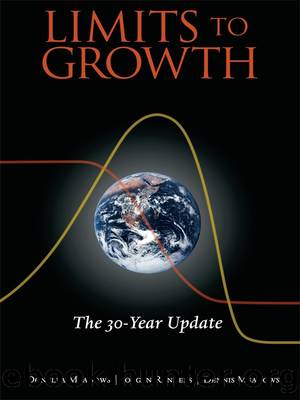Limits to Growth by Donella Meadows Jorgen Randers & Dennis Meadows

Author:Donella Meadows, Jorgen Randers & Dennis Meadows
Language: eng
Format: epub
Tags: ebook, book
Publisher: Chelsea Green Publishing Company
Published: 2011-01-17T16:00:00+00:00
Most PCBs are relatively insoluble in water but soluble in fats, and they have very long lifetimes in the environment. They move quickly through the atmosphere, and slowly through soils or sediments in streams and lakes, until they are taken up into some form of life, where they accumulate in fatty tissue and increase in concentration as they move up the food chain. They are found in the greatest concentrations in carnivorous fish, seabirds and mammals, human fat, and human breast milk.
The impacts of PCBs on the health of humans and other animals are only slowly being revealed. The story is particularly difficult to unravel because PCB is a mixture of 209 closely related compounds, each of which may produce different effects. Nevertheless, it is becoming apparent that some PCBs act as endocrine disrupters. They mimic the action of some hormones, such as estrogen, and block the action of others, such as thyroid hormones. The effect—in birds, whales, polar bears, humans, any animal with an endocrine system—is to confuse delicate signals that govern metabolism and behavior. Especially in developing embryos, even minute concentrations of endocrine disrupters can wreak havoc. They can kill the developing organism outright, or they can impair its nervous system, intelligence, or sexual function.10
Because they migrate slowly, last a very long time, and accumulate in higher levels of a food chain, PCBs have been called a “biological time-bomb.” Although PCB manufacture and use has been banned in many countries since the 1970s,11 a huge stock still exists. Of the total amount of PCBs ever produced, much is still in use or stored in abandoned electrical equipment. In countries with hazardous waste laws, some of these old PCBs are being buried or disposed of by controlled incineration that breaks up their molecular structure and thus their bioactivity. In 1989 it was estimated that 30 percent of all PCBs ever manufactured had already been released into the environment. Only 1 percent had reached the oceans. The 29 percent still unaccounted for was dispersed in soils, rivers, and lakes, where it would go on moving into living creatures for decades.12
Download
This site does not store any files on its server. We only index and link to content provided by other sites. Please contact the content providers to delete copyright contents if any and email us, we'll remove relevant links or contents immediately.
Time Management Made Easy: How to Cultivate New Habits, Improve Productivity and Get Things Done by Joshua Strachan(2366)
The 7 Habits of Highly Effective People by Stephen R. Covey & Sean Covey(2098)
The Concise Laws of Human Nature by Robert Greene(1717)
Doesn't Hurt to Ask by Trey Gowdy(1555)
Primal Leadership by Daniel Goleman(1126)
Hook Point: How to Stand Out in a 3-Second World by Brendan Kane(1098)
HBR's 10 Must Reads 2021 by unknow(1045)
Don't Sweat the Small Stuff...and It's All Small Stuff by Richard Carlson(1015)
Amazon Unbound by Brad Stone(980)
100 Things Successful People Do by Nigel Cumberland(964)
HBR's 10 Must Reads 2021 by Harvard Business Review(956)
The Job Closer by Steve Dalton(939)
Master of One by Jordan Raynor(934)
Lives of the Stoics by Ryan Holiday & Stephen Hanselman(900)
Declutter Your Mind: A step by step guide to learn to control your thoughts, stop worrying, relieve anxiety and eliminate panic attacks and negative thinking by Mia Chandler(875)
The Power of 100! by Shaun King(844)
Conflicted by Ian Leslie(798)
Coders at Work: Reflections on the craft of programming by Peter Seibel(789)
The Book of Hope by Jane Goodall(744)
